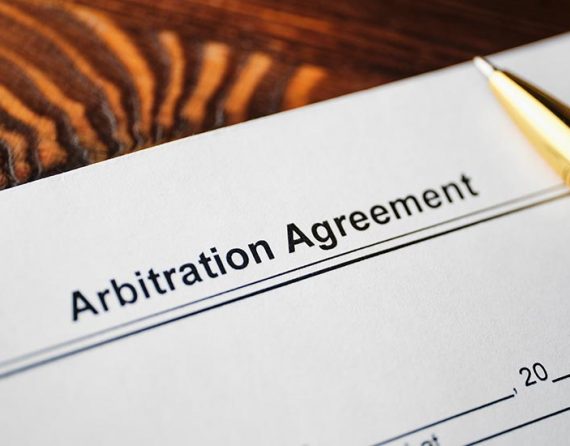The number of construction disputes in the Middle East and North Africa is on the rise, and the average value of construction disputes in this region was around $90 million in 2022.
As the number of disputes grows, it becomes increasingly important to become familiar with resolution methods if you conduct business within this industry.
If you’re seeking clarity on construction dispute resolution, you’re in the right place. Whether you’re currently facing a dispute or you want to be prepared for potential challenges, we will guide you through construction dispute resolution methods and explain how our attorneys at Youssef + Partners can help with a conflict.
What Is Construction Dispute Resolution?
Construction dispute resolution is a combination of the methods and processes used to resolve disagreements that emerge in the construction sector, typically involving parties such as contractors, subcontractors, owners, developers, and suppliers.
These disputes can arise over a variety of issues, including but not limited to:
- Contract terms and interpretations
- Delays or disruptions during construction
- Payment disagreements or claims
- Changes in project scope or design alterations
- Liability issues, including damages or accidents on-site
- Quality of workmanship or materials
The main goal of construction dispute resolution is to ensure that the construction project proceeds smoothly, and stakeholders can find amicable, fair solutions with the help of various dispute methods.
Construction Disputes vs. Construction Claims
While construction disputes are escalated conflicts that arise from unresolved claims, construction claims are formal requests for compensation due to deviations from contract terms.
Construction disputes arise when there is a disagreement over a claim or when multiple claims intersect, indicating that the involved parties could not find a resolution independently. These disputes are more severe forms of conflict and often require external or legal intervention for resolution.
On the other hand, construction claims are initiated by one party towards another due to unforeseen events during a project. These can include delays, unexpected costs, or alterations in the project’s scope. Essentially, they are formal demands for compensation that stem from actions or inactions that diverge from the agreed-upon contract terms.
Types of Construction Disputes
Construction disputes can arise due to misunderstandings or disagreements in any area of a construction project, including timeline, budget and payment.
The most common types of construction disputes are:
- Time disputes: These arise when there are disagreements over the project’s completion date or delays during construction, typically due to unexpected site conditions, variations, or external factors.
- Payment disputes: One of the most common disputes in construction revolves around disagreements over payment terms, amounts, or delays in payment. Payment disputes are currently on the rise due to the increase in the price of materials.
- Safety disputes: Safety disputes emerge when parties argue over adherence to safety protocols, responsibility for accidents, or compliance with health and safety regulations.
- Scope, variation, and instruction disputes: As construction progresses, the need for changes to the initial agreement may arise. Disagreements can then arise over who requested these changes, whether they were necessary, and who should bear the additional costs.
- Schedule disputes: Closely related to time disputes, these disputes focus on disagreements over the project’s planned timeline, including the order and duration of specific tasks. Causes can range from resource shortages to unforeseen complications.
- Design disputes: These disputes occur over design, whether it’s a discrepancy between the envisioned design and the executed one, or disagreements over design responsibilities or errors.
- Quality disputes: These disputes arise when there is a perceived gap between the expected quality of work and the result. Stakeholders may have contractual disputes on whether the work meets defined standards or industry benchmarks.

Construction Dispute Resolution Methods
There are a variety of dispute resolution methods to address and manage disputes. These methods strive to provide an avenue for parties to resolve disagreements efficiently, minimizing delays and unnecessary costs.
The most common construction dispute resolutions methods are:
1. Negotiation
This dispute resolution method entails direct dialogue between the conflicting parties to find common ground and agree on terms. It’s the most informal approach and relies heavily on the willingness of both parties to reach an agreement.
Example: A contractor and the client disagree over the quality of materials used in a residential construction project. Before they escalate the situation, they meet to discuss their concerns directly.
2. Mediation
Mediation involves the assistance of a neutral third party, called the mediator, who does not impose a solution but rather facilitates discussions to guide the disputing parties toward a mutually agreeable resolution. Mediators bring structure to the conversation, ensuring all parties have the opportunity to voice their concerns. If an agreement is reached, it can be made legally binding through a settlement agreement.
Example: During a building renovation, an unexpected foundational issue arises. Both parties use a mediator. The suggested construction mediation is for them to share the unforeseen costs.
3. Arbitration
Arbitration resembles a private court proceeding. The parties present their case to one or more arbitrators who, after considering all submissions, render a binding decision.
Arbitration clauses are frequently found in construction contracts as one of the preferred methods for resolving disputes. This approach offers a more streamlined and confidential way to address disagreements compared to traditional court litigation.
There are various other effective dispute resolution techniques utilized in the industry that cater to different needs and situations besides arbitration and if parties wish to use a method other than what’s specified in their contract, they typically need mutual agreement to do so.
Example: After arbitration, it’s found that both the architect and the client had roles in causing delays. Because both parties were at fault, the architect faced a lesser penalty, implying the client shared some of the financial burdens of the delay.
4. Adjudication
Adjudication involves an appointed adjudicator who reviews the evidence and arguments from both sides, then delivers a decision. This decision is often reached swiftly, making it advantageous for time-sensitive disputes. While the verdict is temporarily binding, parties can still opt to take the issue to arbitration or litigation if the dispute remains unsolved.
Example: After a hotel renovation, the owner disputes the final bill over quality concerns. The two parties enter adjudication. An adjudicator reviews the work and contract, finding minor flaws in the contractor’s work. The owner is ordered to pay the majority of the invoice, with a small deduction for the flaws, providing a swift and binding resolution.
5. Litigation
When other methods fail or are deemed unsuitable, litigation becomes the avenue for dispute resolution. Parties present their case in a court of law, and a judge or jury renders a verdict after thorough evaluation. While it provides a definitive resolution, litigation can be time-consuming, expensive, and can strain business relationships due to its adversarial nature.
Example: A construction firm builds a high-rise office tower downtown. Significant structural defects appear, halting construction. Facing massive financial implications, the developer and construction firm enter into litigation to determine who is liable for the design and construction flaws and to decide who is financially responsible.
6. Small Claims Court
This type of resolution is used for disputes of lesser monetary value, typically below a specified monetary threshold set by the jurisdiction. Small claims courts offer a quicker and less formal route to justice. Procedures are simplified, making it easier for individuals or businesses to represent themselves without the need for legal representation.
Example: A homeowner hires a contractor to refurbish a kitchen. Upon completion, the homeowner identifies improperly installed countertops. The contractor denies responsibility, leading the homeowner to seek resolution in Small Claims Court to determine financial responsibility for rectifying the improperly installed countertops.
7. Expert Determination
Expert determination is a dispute resolution process wherein an independent expert in the subject matter of the dispute is appointed by the parties to resolve the issue.
Example: A large hospital undergoes expansion, requiring specialized medical equipment installation. Upon inspection, disagreements arise between the hospital administration and the construction company about whether the installations meet technical specifications. Both parties agree to expert determination with a medical construction specialist set up to provide a binding decision on financial responsibility.
Construction Dispute Resolution at Youssef + Partners
Youssef + Partners is a market leader in construction, real estate and development matters, and is a go-to firm for regional and MENA international arbitration.
Our arbitration cases have a remarkable track record of a 94% success rate in complex and high value disputes. Whether you’re an employer, contractor, developer, consultant, or industry stakeholder, our arbitration experts are here to ensure that your dispute is handled.
Our arbitration services include:
- Giving legal guidance and strategies for resolving disputes, which covers pre-conflict planning, risk evaluation, and representation
- Drafting and negotiating arbitration contracts and provisions
- Acting on behalf of clients in arbitration cases, whether as the claimant or defendant
- Acting as arbitrators or mediators in disagreements
- Performing in-depth investigations and collecting evidence for arbitration cases
- Managing the enforcement and challenge proceedings related to arbitration awards
- Guiding clients on other dispute resolution methods, like mediation
- Counseling clients regarding international arbitration and investment disputes
Boasting a team of both international and local bilingual attorneys, we recognize local subtleties and are dedicated to being both approachable and pragmatic.
We also represent our clients in significant international arbitration disputes and construction claims across major MENA metropoles, including Cairo, Doha, Dubai, Abu Dhabi and Ras El Khaimah, and key jurisdictions including Turkey, Lebanon, and Kuwait.
Contact us to learn more about how our international arbitration and dispute resolution services can help you protect your business interests.
Examples of Construction Disputes
At Youseff + Partners, we handle all types of construction disputes. Check out some common examples of disputes and resolutions below.
Construction Dispute Example #1
During a construction project, anchored by a detailed blueprint and contractual terms, the engineer issues new directives due to changing needs or unexpected challenges.
These directives are seen by the contracting team as variations — deviations from the initial agreement that are posing significant challenges for project timelines, budgets, and results.
Dispute resolution in this scenario requires:
- Design review: Assess the project design for flaws or changes in vision that led to the engineer’s new directives.
- Contractual language review: Examine the contract to clarify design responsibilities and whether the engineer can make unilateral changes.
- Identification of errors: Identify any design inaccuracies or misunderstandings from the engineer’s instructions.
- Scope definition: Compare any new instructions to the contract’s original scope to confirm if they’re valid variations or part of the initial agreement.
The best resolution methods for this case include negotiation and mediation.
In negotiation, both parties discuss their viewpoints directly. They collaboratively revisit the contract, clarify ambiguous terms, and agree on a revised design that respects the original plan yet incorporates essential changes.
In mediation, a neutral mediator facilitates the discussion, helping both parties express their concerns. Through structured conversations, they identify a shared understanding of the design, clarify contentious contract terms, and reach an amicable resolution.
Construction Dispute Example #2
A large-scale residential complex construction is underway, backed by a consortium of investors. The project’s blueprint involves a unique architectural design and sustainability features, making it a pioneer in green building in the region. However, due to evolving environmental regulations, certain sustainability features in the design become non-compliant.
The design team argues for a design alteration to incorporate newer sustainability tech, while investors, wary of escalating costs, push to retain the original design.
Simultaneously, pre-booked residents of the complex, enticed by the project’s green credentials, threaten lawsuits if the environmental features are dialed down. During this, a key supplier declares bankruptcy, disrupting the supply chain and pushing the project timeline further.
Dispute resolution in this scenario requires:
- Regulatory adaptation: Gauge the extent of the new environmental laws’ impact on the design’s sustainability elements.
- Stakeholder alignment: Mediate between the design team and investors, aiming for a balanced approach that respects both sustainability and budgetary constraints.
- Resident reassurances: Liaise with the early residents, clarifying any modifications and assuaging their legal and environmental concerns.
- Supply chain rectification: Take action to substitute or recover from the loss of the key supplier to ensure the project’s seamless progress.
The best dispute method for this case is mediation. For a dispute as complex as this, mediation would be an appropriate choice, because the conflict involves several parties.
The design team, investors, residents, and suppliers each have their own distinct concerns and interests. Given the long-term nature of construction projects and the potential for future collaborations, preserving relationships is crucial.

How To Prevent Construction Disputes
Being prepared and understanding common mistakes can help you smoothly handle construction projects. By focusing on clarity, communication, and due diligence from the onset, you can significantly reduce the risk of conflicts.
To help prevent construction disputes as either a construction company or a client, follow the tips below:
- Use clear contracts: For instance, if a contract states: “install high-quality tiles,” specify the brand and type of tiles to remove ambiguity.
- Set expectations: Before work begins, have a meeting with the parties involved to formally agree on details, like budget and timeline.
- Depend on reliable job costing systems: Adopt software that tracks labor hours and material costs, ensuring that the project stays within the budget.
- Know your contractual obligations and follow contractual processes: If the contract mandates weekly updates, make it a routine to provide them every Friday.
- Communicate clearly: If unexpected weather delays a project, inform all relevant parties immediately to adjust timelines.
- Document everything: If a client requests a change, such as a different paint color, ensure it’s documented and both parties sign off on it.
- Pay on time: Set calendar reminders for payment milestones, such as “30% payment upon foundation completion.”
- Familiarize yourself with the building process: By understanding phases like site preparation, foundation work, and framing, you’re better equipped to anticipate potential challenges.
- Remember the important details you agreed on: Use tools or apps to highlight and recall specific clauses or terms discussed, ensuring they aren’t overlooked.
- Ask for help from a legal expert: If a term in the contract seems unclear, seek legal counsel before work begins to prevent potential disputes.
Credits go to team members including César R. Ternieden.




